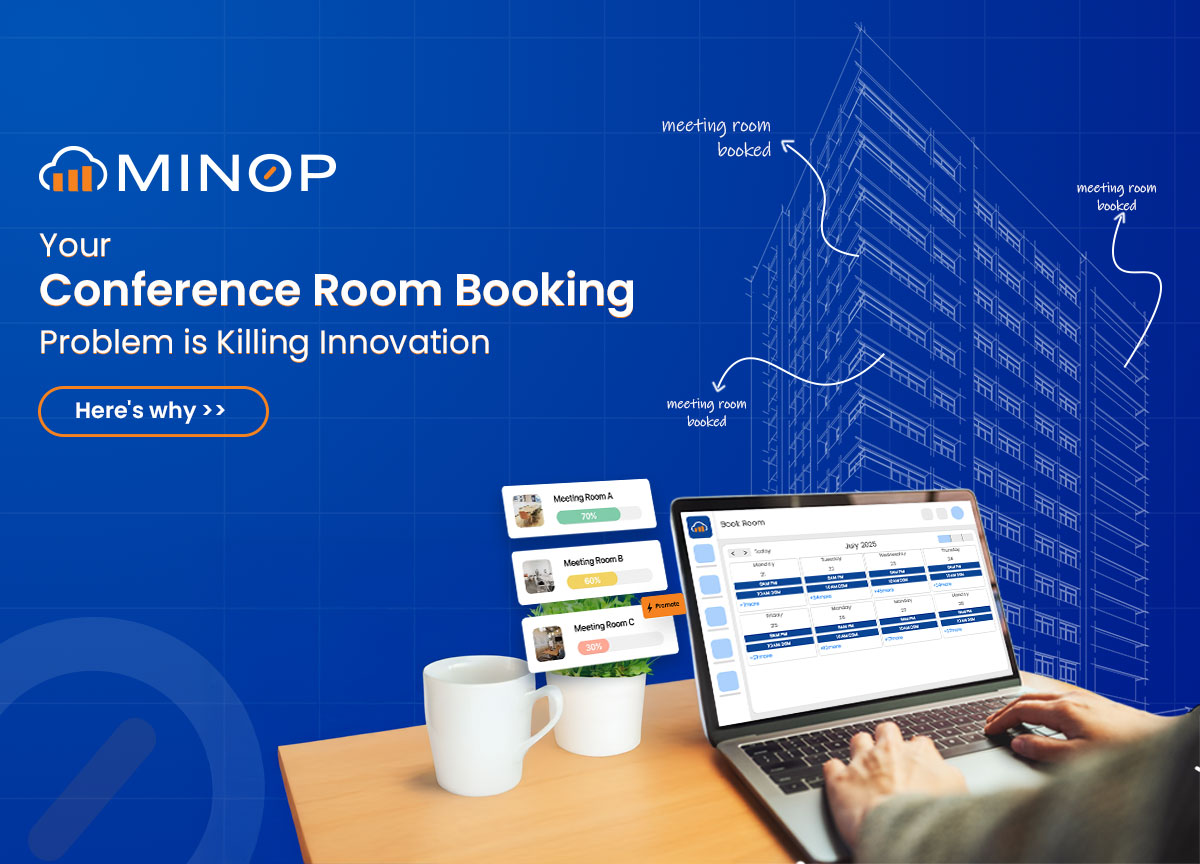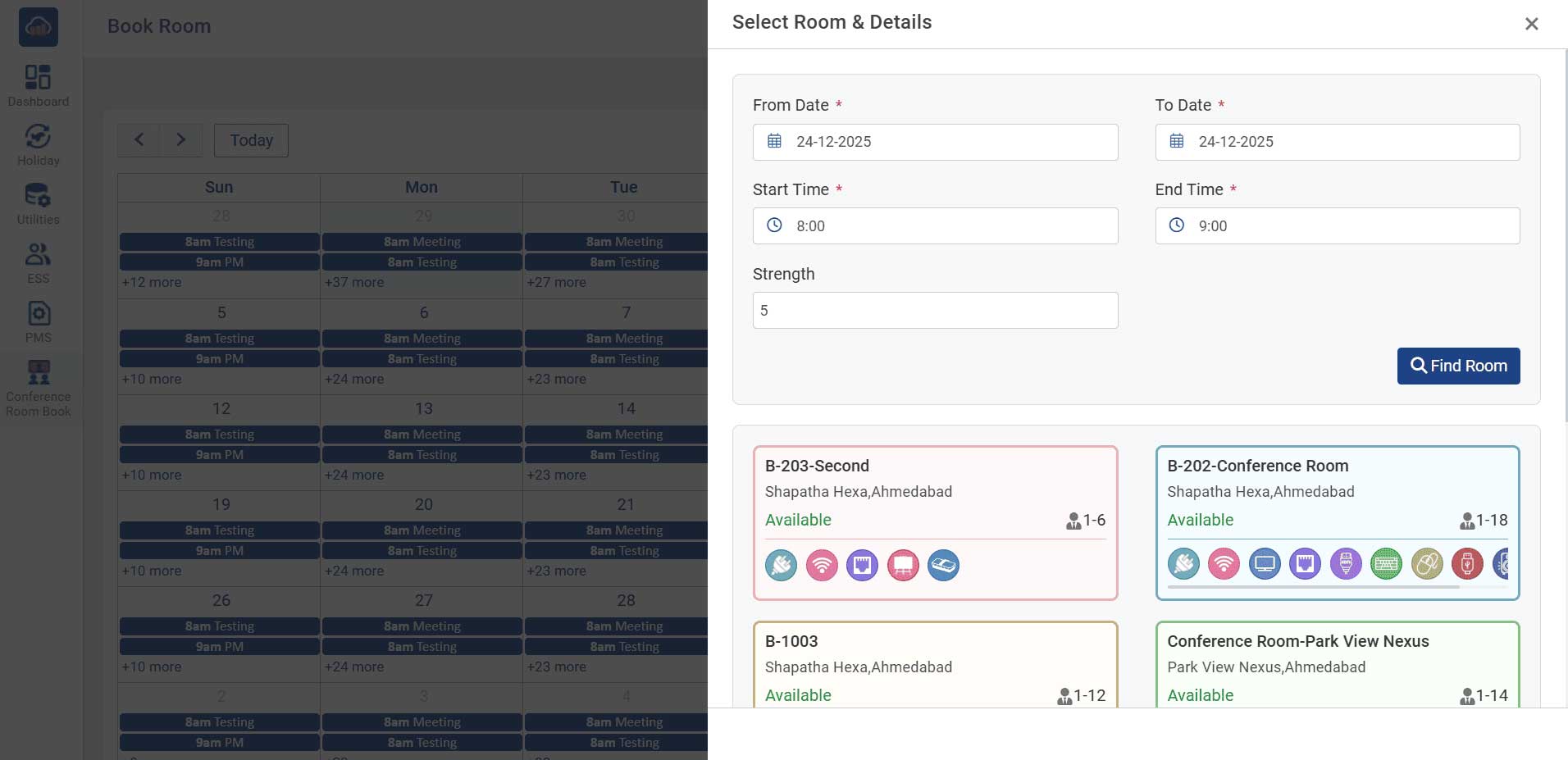Your Conference Room Booking Problem is Killing Innovation (Here's the Fix)
Posted On:- 9 September, 2025 By:- Vaibhav Maniyar
Introduction
Your engineering team just cracked a breakthrough approach to your product's biggest bottleneck. They need a room with a whiteboard now, to map it out before the insight fades. Fifteen minutes later, they're still searching. By the time they find space, the moment is gone.
This minute scheduling problem disrupts innovation and prevents critical defining moments from coming up altogether.
Recently, a survey found that employees waste an average of 30 minutes per day searching for meeting spaces or dealing with booking conflicts. For a 100-person company, that's 50 lost hours every single day and 6,250 hours annually. But the real cost isn't just time. It's the ideas that never get captured, the momentum that evaporates, and the culture of friction that slowly replaces a culture of creation.
Common Conference Room Booking Challenges
The most innovative companies share a surprising trait: they ruthlessly eliminate friction from the creative process. When Pixar designed its headquarters, Steve Jobs famously insisted on a central atrium that forced "random collisions" between employees. But physical proximity only works if teams can immediately act on their ideas.
Dr. Teresa Amabile's Harvard research on workplace creativity identified "flow interruption" as one of the top killers of innovation. Her 12,000-day study which tracked knowledge workers found that even minor logistical barriers, such as hunting for meeting space, significantly reduced creative output over time.
The conference room scramble creates three specific innovation barriers:
Lost Opportunities
Breakthrough ideas have a shelf life measured in minutes, not hours. When MIT researchers studied innovation teams, they found that spontaneous collaboration sessions (under 30 minutes, unscheduled) generated 40% more patentable ideas than scheduled brainstorms. But these sessions only happened when space was immediately available.
Booking Scarcity
When employees perceive meeting rooms as scarce resources, they shift into a scarcity mindset. They book rooms defensively, hoard time "just in case," and avoid collaboration that might require coordination. Stanford professor Sendhil Mullainathan's research on scarcity shows this creates a cognitive tax that reduces creative problem-solving capacity by up to 13 IQ points.
Negative Perception
Nothing undermines client confidence faster than operational chaos. When a prospect sees your team scrambling for meeting space or getting kicked out mid-presentation, they question your ability to execute on complex projects. Innovation requires client trust, and trust starts with operational competence.
Smart Conference Room Booking Features
The conference room booking systems that drive measurable innovation outcomes have evolved far beyond digital calendars. Here's what separates genuinely intelligent systems from feature checklists:
Seamless Scheduling
Basic systems show you which rooms are free right now. Intelligent systems use historical data and calendar integration to predict when conflicts will emerge. If your weekly product meeting consistently runs 20 minutes over, the system automatically suggests booking an adjacent time or a larger window. This prevents the downstream scramble that kills afternoon productivity.
In other words, the hallway conversation that sparks a solution to a client problem needs a room to sketch it out, but the current booking system shows the nearest room with a whiteboard is across the building and available in 45 minutes. By then, you have three other meetings, and that idea never got a brainstorming session.
Instead, a predictable booking system embedded with a real-time map shows a huddle room 20 feet away, available now. Three minutes later, you're whiteboarding and the idea becomes a client proposal by end of day.
Related: Smart Attendance System is Essential for Your Business Success
Pattern Analysis
The best systems learn from your organization's patterns. They:
- Notice that a certain team prefers afternoon working sessions in specific rooms with natural light.
- Identify that huddle rooms near the break room get booked for longer sessions.
- Flag rooms that consistently get bad feedback on video quality.
For instance, for a half-remote working product team, someone books a conference room for the weekly planning session, but forgets to verify the quality of the web camera. As a result, the remote team barely sees the whiteboard, and they disengage with the ideas put up, preventing critical decisions from being made in the first place.
Instead, a cloud-based conference room booking system shows all the facilities available before booking the room based on the strength of the people and the agenda of the meeting. The person booking can automatically filter for "hybrid-optimized" rooms with 360° cameras, multiple mics, and wireless screen sharing. As a result, the meeting happens seamlessly. Remote team members contribute equally. Decisions are documented in real-time.

Conference Room Booking Calendar
Tools that exist in isolation die from lack of adoption. Your booking system should plug into an in-built calendar (so it knows team locations and remote status), and ideally your badge access system.
The foundation is a real-time, centralized calendar showing the status of every meeting room. This instantly eliminates double bookings and provides a clear, accurate overview for everyone. No more confusion, no more conflicts.

When the calendar is at the core of the system, the booking process feels effortless. Teams can see exactly what's free, what's in use, and where people are working – all in one place. It's this single source of truth that keeps the workplace coordinated, predictable, and conflict-free.
Every booking is laid out with clear time slots, room names, and simple colour codes, so availability can be spotted in seconds without scanning through endless details.
Clicking on any entry brings up full meeting information, including the organiser, location, and specific room reserved, giving everyone the clarity they need before walking in.
Moreover, the sidebar keeps everyday essentials close at hand, whether it's the dashboard, holiday list, utilities, PMS, ESS, or conference room booking itself.
Lastly, with the flexibility to switch between month, week, or day views, the calendar works the way teams do – providing a live, reliable picture of room usage that removes confusion, avoids overlaps, and makes scheduling smoother for everyone.
Related: 6 Essential Features to Consider in Your Time and Attendance System
Conference Room Booking Implementation: Best Practices
When organisations introduce conference room booking platforms, it's tempting to see them as a purely logistical tool. But the technology alone doesn't guarantee efficiency. The companies that extract real value understand that meeting spaces are not just physical assets — they are cultural touchpoints.
The difference between a system that sits unused and one that transforms workplace culture comes down to three practices:
From Room Hoarding to Shared Accountability
The silent drain on productivity isn't a lack of rooms but the misuse of them. Ghost meetings — bookings that never materialise — lock out others who genuinely need the space. Modern booking systems can counter this by automatically cancelling no-shows, surfacing analytics on usage patterns, and integrating with an Attendance API to verify check-ins and track real-time participation - making the invisible visible.
Aligning Meeting Modes with Space Design
Not all meetings are created equal, yet many organisations treat all rooms as interchangeable. The result is misfit: two people taking up a twelve-seat boardroom, or a critical client pitch squeezed into a space with no A/V support. The best implementations treat the room portfolio as layered: phone booths for calls, huddle rooms for agile working sessions, standard rooms for team updates, and premium setups for high-stakes external conversations.
Optimisation as an Ongoing Discipline
Meeting culture is never static. A booking platform should be treated less as a procurement decision and more as a living system. Organisations that thrive track utilisation metrics quarterly, run surveys to capture friction points, and cross-analyse data with employee experience. This proactive stance turns analytics into foresight: issues are spotted before they calcify into cultural frustrations.
Final Thoughts
The companies that consistently ship breakthrough products, win competitive deals, and retain creative talent share an obsession with removing barriers to collaboration. They understand that ideas are fragile. Momentum is fleeting. And the window between "I have an insight" and "I'm doing something about it" is measured in minutes. A genuinely intelligent conference room booking system ensures that when your team has a breakthrough, they can act immediately. When your client arrives, they see competence. When your remote employees join, they're truly included.
FAQs
What is a conference room booking system?
A conference room booking system is a digital platform that manages meeting space reservations in real-time, eliminating double bookings and scheduling conflicts. The best systems go beyond basic scheduling to offer predictive availability, usage analytics, and context-aware suggestions based on meeting type and attendee needs.
What features matter most in conference room booking software?
Prioritize location intelligence so employees can book nearby rooms in under 30 seconds from their phones. Deep calendar integration is essential; the system must have in-built calendar so bookings appear automatically. Actionable analytics should surface insights like underutilized rooms, peak booking times, and ghost meeting rates without manual reporting.
What ROI can we expect from conference room booking implementation?
Organizations typically see immediate elimination of double-booking conflicts and reclaim an average of 30 minutes per employee per week previously spent searching for rooms. Within 30-90 days, companies experience 25-35% reduction in meeting start delays and 34% fewer scheduling conflicts on average. Long-term benefits include 18% more spontaneous collaboration sessions and improved space utilization that often reveals 20-30% underutilized capacity.
Do a conference room booking system actually help hybrid teams?
Yes, but only with context-aware features that go beyond basic video conferencing integration. The system should read calendar invitations to identify remote attendees and automatically filter for hybrid-optimized rooms with 360° cameras, multiple microphones, and wireless screen sharing. Advanced systems flag potential participation imbalances and suggest room configurations that ensure equal engagement for in-office and remote employees.
What implementation mistakes should we avoid?
The biggest mistake is treating this like buying new software instead of changing how people work, which needs leadership support and clear communication. Companies fail when they don't stop employees from booking rooms they don't use through auto-cancellation after 10 minutes and limits on advance booking. Track results every three months like room usage, booking problems, and employee happiness, then adjust your rules based on what you learn.

Comments